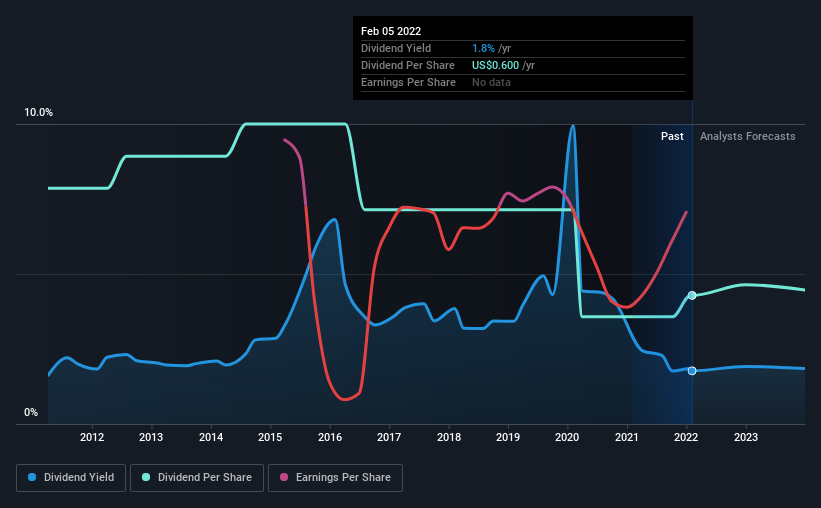It Might Not Be A Great Idea To Buy Murphy Oil Corporation (NYSE:MUR) For Its Next Dividend
Regular readers will know that we love our dividends at Simply Wall St, which is why it's exciting to see Murphy Oil Corporation (NYSE:MUR) is about to trade ex-dividend in the next four days. The ex-dividend date is one business day before the record date, which is the cut-off date for shareholders to be present on the company's books to be eligible for a dividend payment. The ex-dividend date is important as the process of settlement involves two full business days. So if you miss that date, you would not show up on the company's books on the record date. Accordingly, Murphy Oil investors that purchase the stock on or after the 11th of February will not receive the dividend, which will be paid on the 1st of March.
The company's next dividend payment will be US$0.15 per share, and in the last 12 months, the company paid a total of US$0.60 per share. Based on the last year's worth of payments, Murphy Oil has a trailing yield of 1.8% on the current stock price of $33.86. We love seeing companies pay a dividend, but it's also important to be sure that laying the golden eggs isn't going to kill our golden goose! As a result, readers should always check whether Murphy Oil has been able to grow its dividends, or if the dividend might be cut.
See our latest analysis for Murphy Oil
If a company pays out more in dividends than it earned, then the dividend might become unsustainable - hardly an ideal situation. Murphy Oil's dividend is not well covered by earnings, as the company lost money last year. This is not a sustainable state of affairs, so it would be worth investigating if earnings are expected to recover. Considering the lack of profitability, we also need to check if the company generated enough cash flow to cover the dividend payment. If Murphy Oil didn't generate enough cash to pay the dividend, then it must have either paid from cash in the bank or by borrowing money, neither of which is sustainable in the long term. What's good is that dividends were well covered by free cash flow, with the company paying out 11% of its cash flow last year.
Click here to see the company's payout ratio, plus analyst estimates of its future dividends.
Have Earnings And Dividends Been Growing?
Businesses with shrinking earnings are tricky from a dividend perspective. Investors love dividends, so if earnings fall and the dividend is reduced, expect a stock to be sold off heavily at the same time. Murphy Oil was unprofitable last year and, unfortunately, the general trend suggests its earnings have been in decline over the last five years, making us wonder if the dividend is sustainable at all.
Another key way to measure a company's dividend prospects is by measuring its historical rate of dividend growth. Murphy Oil's dividend payments per share have declined at 5.9% per year on average over the past 10 years, which is uninspiring. It's never nice to see earnings and dividends falling, but at least management has cut the dividend rather than potentially risk the company's health in an attempt to maintain it.
Remember, you can always get a snapshot of Murphy Oil's financial health, by checking our visualisation of its financial health, here.
Final Takeaway
Is Murphy Oil an attractive dividend stock, or better left on the shelf? First, it's not great to see the company paying a dividend despite being loss-making over the last year. On the plus side, the dividend was covered by free cash flow." Overall it doesn't look like the most suitable dividend stock for a long-term buy and hold investor.
Although, if you're still interested in Murphy Oil and want to know more, you'll find it very useful to know what risks this stock faces. Every company has risks, and we've spotted 3 warning signs for Murphy Oil you should know about.
We wouldn't recommend just buying the first dividend stock you see, though. Here's a list of interesting dividend stocks with a greater than 2% yield and an upcoming dividend.
Have feedback on this article? Concerned about the content? Get in touch with us directly. Alternatively, email editorial-team (at) simplywallst.com.
This article by Simply Wall St is general in nature. We provide commentary based on historical data and analyst forecasts only using an unbiased methodology and our articles are not intended to be financial advice. It does not constitute a recommendation to buy or sell any stock, and does not take account of your objectives, or your financial situation. We aim to bring you long-term focused analysis driven by fundamental data. Note that our analysis may not factor in the latest price-sensitive company announcements or qualitative material. Simply Wall St has no position in any stocks mentioned.

